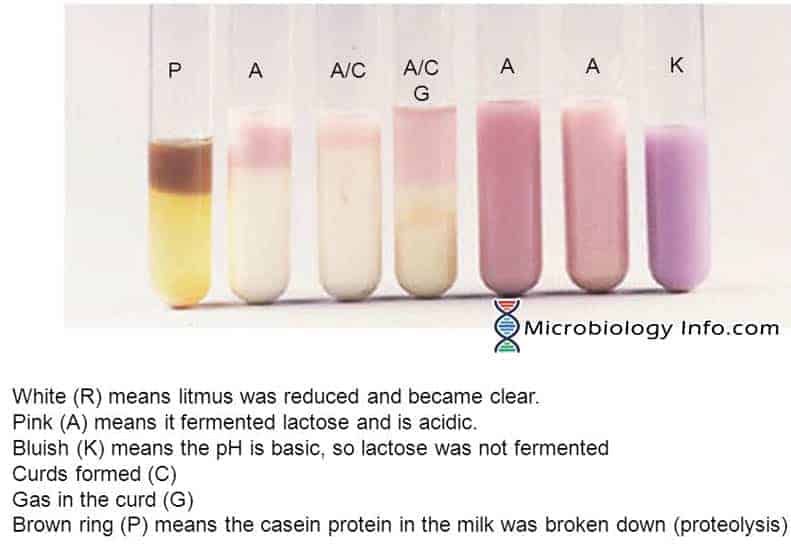Milk is an excellent medium for the growth of microorganisms because it contains the milk protein casein, the sugar lactose, vitamins, minerals and water. Litmus milk is a milk-based medium used to distinguish between different species of bacteria.
The lactose (milk sugar), litmus (pH indicator), and casein (milk protein) contained within the medium can all be metabolized by different types of bacteria. The test differentiates microorganisms based on various metabolic reactions in litmus milk, including reduction, fermentation, clot formation, digestion, and the formation of gas.
Objectives
- To determine an organism’s ability to metabolize litmus milk.
- To differentiate among microorganisms that enzymatically transforms different milk substrates into varied metabolic end products.
Principle
The major milk substrates capable of transformation are the milk sugar lactose and the milk proteins casein, lactalbumin, and lactoglobulin. To distinguish among the metabolic changes produced in milk, a pH indicator, the oxidationreduction indicator litmus, is incorporated into the medium. Litmus milk then forms an excellent differential medium in which microorganisms can metabolize milk substrates depending on their enzymatic complement. A variety of different biochemical changes result.
Fermentation of lactose is demonstrated when the litmus turns pink as a result of acid production. If sufficient acid is produced, casein in the milk is coagulated, solidifying the milk. With some organisms, the curd shrinks and whey is formed at the surface. Some bacteria hydrolyze casein, causing the milk to become straw colored and resemble turbid serum. Additionally, some organisms reduce litmus, in which case the medium becomes colorless in the bottom of the tube.
Media:
Powdered skim milk (100 g), litmus (0.5 g), sodium sulphite (0.5 g), per 1000 mL, pH 6.8.
Method
- Inoculate with 4 drops of a 24-hour broth culture.
- Incubate at 35°-37°C in ambient air.
- Observe daily for seven days for alkaline reaction (litmus turns blue), indicator reduction, acid clot, acid reaction (litmus turns pink), rennet clot, and peptonization.
- Record all changes.
Expected Results
Multiple changes can occur over the observation period.

Positive test
- Acid pH: pink to red color
- Alkaline pH: purplish- blue color
- Reduction: white
- Acid curd: hard curd with clear supernatant (whey)
- Digestion: Dissolution of clot with clear, grayish, watery fluid and a shrunken, insoluble pink clot
- Rennet curd: soft curd followed by peptonization (alkaline pH, supernatant brown)
- Gas production: bubbles in coagulated milk
Negative test:
- Color and consistency remain same.
Uses
- The litmus milk test differentiates members of the Enterobacteriacaeae from other gram-negative bacilli based on the enterics’ ability to reduce litmus.
- It is commonly used to differentiate members within the genus Clostridium.
- It mainly aids in the identification and differentiation of Enterococcus, and Lactic acid bacteria. The media may also be used to grow lactic acid bacteria.
Limitations
- Litmus media reactions are not specific and you should do additional tests for definitive identification of microorganisms.
- Litmus milk is a complex medium that can produce a diversity of results. Because of this, litmus milk can give quite unreliable results.
- A clot formation is simply recorded as “clot” and cannot clearly differentiate between a clot and curd formation in this medium.
References
- Tille, P. M., & Forbes, B. A. (2014). Bailey & Scott’s diagnostic microbiology (Thirteenth edition.). St. Louis, Missouri: Elsevier.
- Cappuccino J.G. and Sherman N. 2008. Microbiology: A Laboratory Manual, 8th ed. Pearson Benjamin Cummings, San Francisco, CA, USA.
- vlab.amrita.edu/?sub=3&brch=76&sim=708&cnt=2
- spot.pcc.edu/~jvolpe/b/bi234/lab/differentialMedia/litmus_milk.htm
